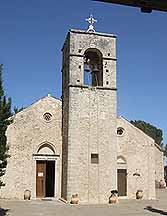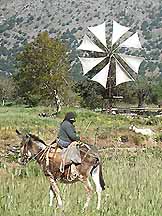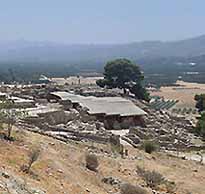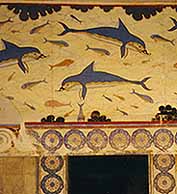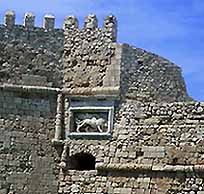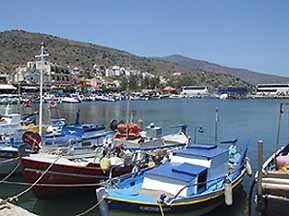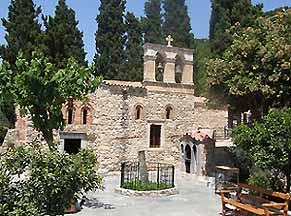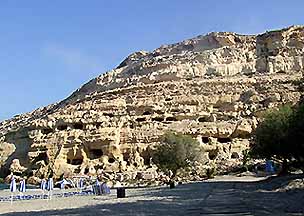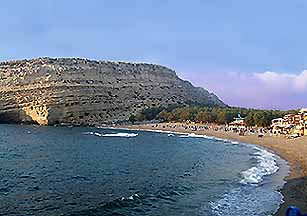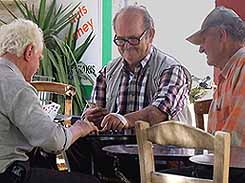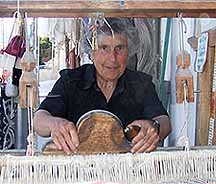Discovering Crete
Greece’s Largest and Most Impressive Isle
Our flight cleared the Iraklio airport, heading northwest towards Athens in continuation of our Greek Islands holidays. As we enjoyed our last views of Crete, I queried my wife, Rita, for a one-word summary of Greek's largest island. She didn't ponder. "Unique!! There are so many images of Crete racing through my mind... all of those images are truly UNIQUE!" I viewed the snow-capped peaks, rugged coastline and crystalline sea, and thought of the Minoan and Venetian sites we'd visited and the interesting people we'd met - fishermen, farmers, weavers, clerics, and villagers. "Unique," I agreed, realizing there was no more fitting word to describe our week of Cretan explorations.
|
|
|
|
Enthralling History
Crete is one of the rare places on our planet with historical sites dating back more than 4,000 years. The ancient civilization was coined "Minoan" after King Minos who resided over the island in approximately 2500 B.C. His palace, Knossos, was fabled for its labyrinth and mythical Minotaur, half man - half bull. British archaeologist Arthur Evans excavated the site in the early 1900s, and he took the liberty of reconstructing part of the multi-storied structure. It contains numerous relics including mosaic floors, murals, columns, and storage rooms with large urns. My wife and I gladly spent most of a day touring the huge complex, definitely the most complete of Crete’s Minoan establishments. We also visited the Minoan sites of Gournia and Festos. The latter sits atop a beautiful hill with views of a lush valley and the Psiloritis Mountains towering to the north. Many of the original artifacts of Crete’s Minoan sites are on display in the archaeological museum in the capital city of Iraklio. [The museum is currently being refurbished, with reopening scheduled for 2009].
|
|
|
|
Crete’s capital was definitely worth our daylong visit due to its Venetian fort and network of streets dating from the 1200s to the 1600s. Iraklio today bustles with the activity of shoppers and office-workers while proudly displaying its history. Although the Ottomans overtook the city in 1669, the city still reflects its Venetian heritage: the central squares lined with cafes sport sparkling centuries-old fountains; the fort, with seven bastions and 40-foot-thick walls, sits formidably guarding the beautiful inner harbor.
Elounda – The Perfect Vacation
Spot
We based ourselves in the quiet fishing village of Elounda, just meters from its boat harbor and shoreside restaurants. It was the perfect spot to enjoy a day of hiking, cycling, beach lounging or to strike out for the best sites of western and central Crete. Our rental apartment gave us a good view to the sea and the island of Spinalonga. Each morning we’d walk down the steep hill to the local market where the friendly proprietor supplied us with fresh strawberries, yogurt and bread for breakfast on our terrace. Most evenings we treated ourselves to a seaside dinner at Olondi Restaurant. Here we discovered our favorite Greek dish, a sampler plate of ten mezes (“appetizers”) such as tiropitakia (cheese pies), dolmadakia (vine leaves stuffed with beef and rice), kolokithokeftedes (zucchini fritters), melitzanes tiganites (fried eggplant), tzatziki (yogurt, cucumber, and garlic dip), feta (the famous Greek cheese), and souvlakia (beef or pork kebab). Sharing this plate was all we required for a satisfying dinner. How’s 20 euros for two including an excellent red house wine and gratuity?
|
|
|
From Elounda we were able to make day-long exploratory tours: north for a hike up the mountain above Mirambelou Bay; south to the town of Agios Nikolaos with its beautiful inner harbor and the nearby Minoan site of Gournia as well as the Byzantine hill village of Kritsa; west to the isolated agricultural plateau, Lasithi, with its ancient farming methods and wind mills still in operation. On one occasion we ventured southwest across the island for an overnight stay in the beach village of Matala with its cliff caves and troglodyte homes. This afforded us the opportunity to take in the beautiful Minoan site of Festos, enjoy a long hike through the Rouvas Gorge, visit monasteries such as Vrondisi, and explore Iraklio and Knossos Palace on our return.
|
|
|
Friendly Cretans
Our most striking memories of Crete are its residents. The proprietor of our favorite restaurant told us the history of his family fishing and raising olives around Elounda. He proudly spoke of his boat and his mastery of the seas. On the Vasithi Plateau we met a woman weaver in a small village who demonstrated her craft on an ancient loom. In the same region we viewed farmwomen on their donkeys trekking to and from local markets past cloth-ribbed windmills. In the mountains and gorges of the interior we toured monasteries and met Orthodox priests and nuns who proudly showed us the historical sites of their compounds, often dating back to Byzantine times. In Vori village in the Psiloritis foothills we viewed a high-energy card game at the small main square’s café. It was hard to spend too much time sitting on a tourist beach on Crete, no matter how attractive, when the real Crete and its residents were awaiting our discovery.
|
|
|
|
How About Hania, Rethimno, the Samarias Gorge?
Our time on Crete was both busy and fun as we followed our whims for exploration and discovery. But at the end of an incredibly unique week we knew we’d just scratched the surface. We must someday return to see sites on the western side of the island. Venetian Hania town is on the top of our list. We may even tackle the long Samaria Gorge that winds narrowly between upright walls for 10 miles from the mountains to the sea. On reflection, why not spend two weeks or a month on Crete? We know the isle will again surprise us with its uniqueness.
|
|
Les Furnanz
Photos by Rita Furnanz
